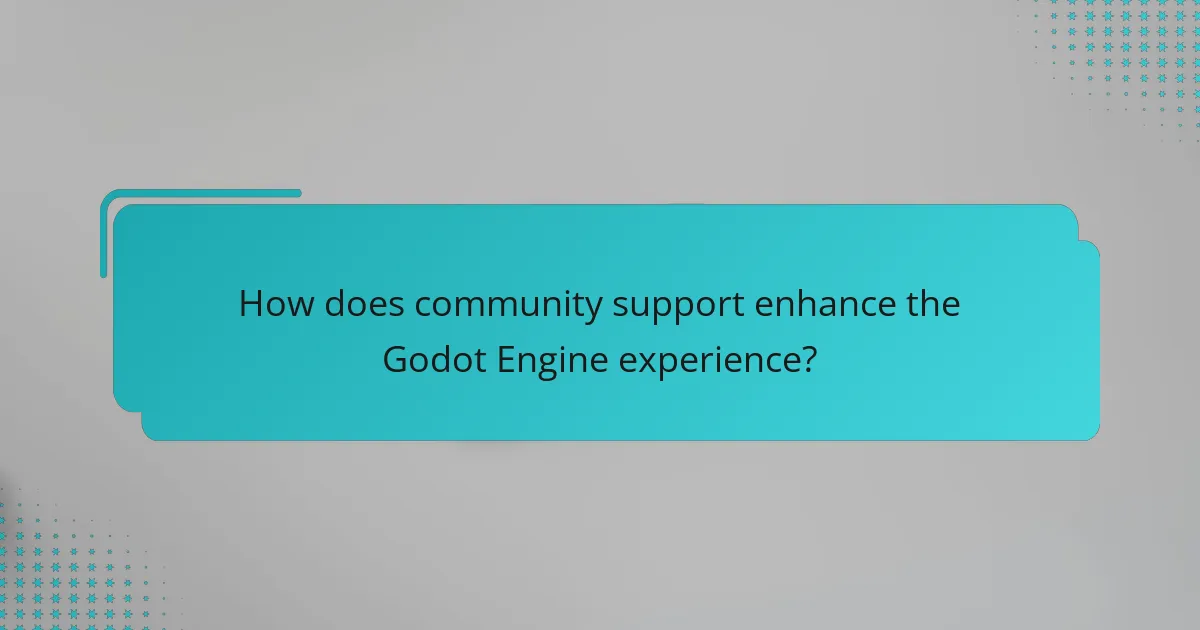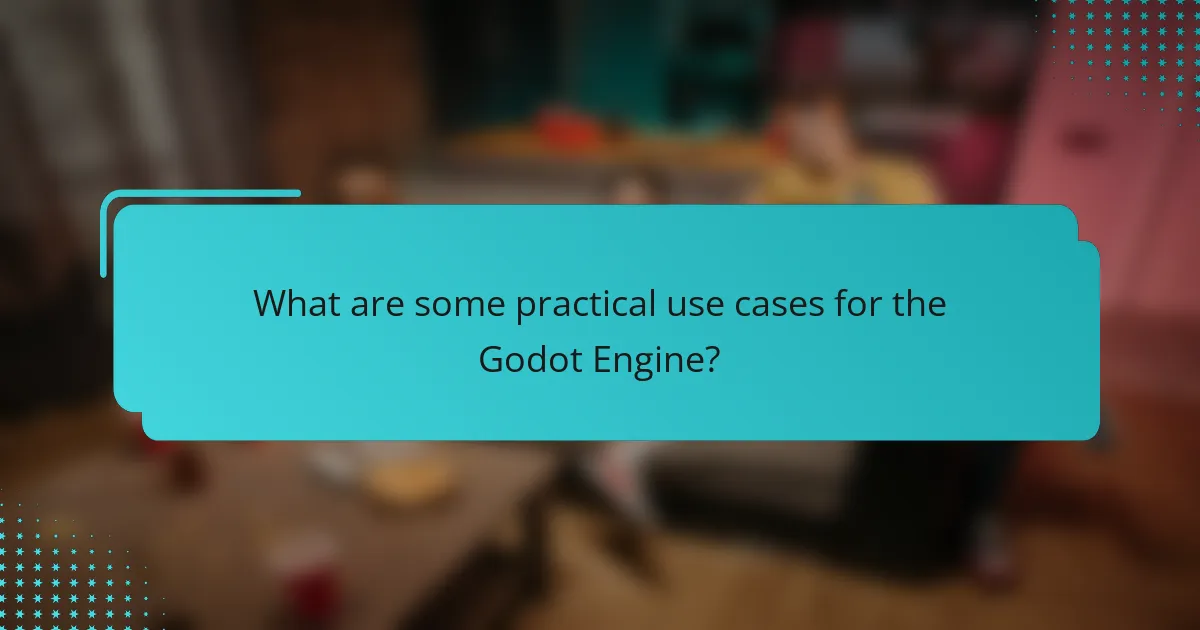
What is the Godot Engine?
The Godot Engine is an open-source game development platform. It allows users to create 2D and 3D games. Godot provides a user-friendly interface and a flexible scene system. It supports multiple programming languages, including GDScript, C#, and VisualScript. The engine is designed for ease of use and efficiency. Godot has a strong community that contributes to its continuous improvement. It is widely used for indie game development and educational purposes. Godot is licensed under the MIT License, ensuring freedom to use and modify the software.
How does the Godot Engine function as an open-source platform?
The Godot Engine functions as an open-source platform by allowing anyone to access, modify, and distribute its source code. This accessibility fosters collaboration among developers. Users can contribute to the engine’s development by submitting code improvements or bug fixes. The engine is licensed under the MIT License, promoting freedom and flexibility in its use. Community-driven development leads to rapid updates and feature enhancements. Users benefit from a wealth of shared resources, including tutorials and documentation. This collaborative environment encourages innovation and helps address user needs effectively. Overall, Godot’s open-source nature empowers a diverse community to shape its evolution.
What are the key features of the Godot Engine?
The Godot Engine has several key features that distinguish it from other game development platforms. It offers a fully integrated development environment that supports both 2D and 3D game development. The engine uses a unique scene system for organizing game elements, which enhances modularity and reusability. Godot provides a powerful scripting language called GDScript, designed specifically for game development, which is easy to learn and use.
Additionally, the engine supports visual scripting, allowing developers to create game logic without writing code. Godot is open-source, which means developers can modify the engine’s source code to fit their needs. It also boasts a large and active community that contributes to a wealth of tutorials and resources. The engine supports multiple platforms, enabling developers to export games to Windows, Linux, macOS, Android, iOS, and HTML5.
Lastly, Godot features a comprehensive animation system that allows for intricate animations and transitions, enhancing the visual appeal of games.
How does the Godot Engine compare to other game engines?
The Godot Engine is a versatile open-source game engine that offers unique advantages compared to other game engines. It supports both 2D and 3D game development, which many engines do not handle as effectively. Godot’s scripting language, GDScript, is designed specifically for game development, making it user-friendly for beginners.
In contrast, engines like Unity and Unreal Engine use more complex languages such as C# and C++. Godot’s lightweight design allows for faster performance and shorter loading times. Additionally, it has a smaller footprint compared to larger engines, which can be resource-intensive.
Godot’s community-driven development model leads to regular updates and a wide range of plugins. This is in contrast to proprietary engines, which may have limited customization options. Godot’s licensing allows for complete freedom in using and modifying the engine without any royalties or fees.
This open-source nature fosters collaboration and innovation within the community. Overall, Godot Engine stands out for its ease of use, flexibility, and supportive community compared to other game engines.
What are the core advantages of using the Godot Engine?
The core advantages of using the Godot Engine include its open-source nature, a user-friendly interface, and a strong community support system. The engine is completely free, allowing developers to use it without licensing fees. Godot supports both 2D and 3D game development, making it versatile for various projects. It features a unique scene system that promotes modular design and reusability of assets. The engine uses its own scripting language, GDScript, which is easy to learn for beginners. Additionally, Godot has a rich set of built-in tools that streamline the development process. The active community provides extensive documentation and tutorials, enhancing accessibility for new users. Overall, these features contribute to a flexible and efficient game development environment.
How does the open-source nature of Godot benefit developers?
The open-source nature of Godot benefits developers by providing free access to its source code. This allows developers to customize the engine to fit their specific needs. They can modify features, fix bugs, and experiment with new ideas without restrictions. Open-source licensing encourages collaboration among developers. They can share improvements and enhancements with the community. This leads to a more robust and versatile engine over time. Additionally, developers benefit from a supportive community that offers resources and knowledge sharing. According to the Godot community, many developers contribute to its continuous improvement, fostering innovation.
What cost savings can developers expect when using Godot?
Developers can expect significant cost savings when using Godot due to its open-source nature. Godot is free to use, eliminating licensing fees associated with many commercial game engines. This allows developers to allocate budget resources towards other project areas, such as art or marketing.
Additionally, Godot’s active community provides extensive documentation and support, reducing the need for paid training or external consulting services. Developers can also save on costs related to platform deployment since Godot supports multiple platforms without additional fees.
Moreover, the engine’s lightweight design can lead to lower hardware requirements, minimizing expenses on high-end development machines. Overall, using Godot can result in a more cost-effective development process while maintaining quality.

How does community support enhance the Godot Engine experience?
Community support significantly enhances the Godot Engine experience. It provides users with access to a wealth of shared knowledge and resources. The community offers tutorials, documentation, and forums for problem-solving. This collaborative environment fosters innovation and creativity among developers. Users can share their projects and receive constructive feedback. Active community engagement leads to faster bug fixes and feature updates. The Godot community regularly contributes to the engine’s development through open-source contributions. This collective effort ensures that the engine remains robust and up-to-date. Overall, community support enriches the usability and functionality of the Godot Engine.
What resources are available through the Godot community?
The Godot community offers a variety of resources for developers. These include official documentation, which provides comprehensive guides and tutorials. Community forums facilitate discussions and troubleshooting among users. Additionally, there are numerous online courses available for learning Godot. The community also hosts regular events and game jams to encourage collaboration. GitHub repositories contain open-source projects and plugins for extended functionality. Users can access a wealth of user-generated content, including assets and scripts. Lastly, social media groups provide platforms for sharing knowledge and networking with other developers.
How can developers contribute to the Godot community?
Developers can contribute to the Godot community by participating in code development, documentation, and community support. Contributing code involves submitting improvements or bug fixes to the Godot engine on GitHub. Documentation contributions help users understand the engine better and improve usability. Developers can also engage in community forums and answer questions to assist newcomers. Additionally, creating tutorials and resources enhances learning opportunities for others. The Godot community values contributions as it fosters collaboration and growth. This collaborative approach has led to a vibrant ecosystem that supports ongoing development and innovation.
What role do forums and social media play in community support?
Forums and social media serve as vital platforms for community support. They facilitate communication among users, enabling them to share experiences and solutions. Forums often host discussions that provide technical assistance and troubleshooting advice. Social media platforms allow for real-time updates and community engagement. Users can ask questions and receive prompt responses from peers. This interaction fosters a sense of belonging and collaboration. According to a study by Pew Research Center, 69% of adults in the U.S. use social media, highlighting its role in connecting communities. Overall, these platforms enhance knowledge sharing and strengthen community ties.
How does community feedback influence the development of Godot?
Community feedback significantly influences the development of Godot. The Godot development team actively engages with users through forums, GitHub, and social media. This interaction allows developers to gather insights on user needs and preferences. Feedback often leads to feature requests and bug reports that shape the engine’s roadmap. For example, community suggestions have resulted in improved documentation and enhanced tools. The open-source nature of Godot encourages contributions from users, which further refines the engine. Developers prioritize changes based on community input, ensuring that updates align with user expectations. This collaborative approach fosters a responsive and adaptable development environment.
What are some recent updates driven by community input?
Recent updates driven by community input for the Godot Engine include improved documentation and enhanced user interface features. These changes were implemented based on feedback from users highlighting areas for better clarity and usability. Additionally, the community contributed to bug fixes and performance optimizations, which are reflected in the latest release notes. Community-driven proposals also led to the introduction of new tools for game developers, enhancing workflow efficiency. These updates demonstrate the active involvement of the community in shaping the engine’s development.
How can users report bugs or suggest features effectively?
Users can report bugs or suggest features effectively by following specific guidelines. First, they should provide a clear and concise description of the issue or suggestion. Including steps to reproduce the bug enhances clarity. Users should also specify the version of the Godot Engine they are using. Providing screenshots or error messages can help developers understand the problem better. Posting on official forums or GitHub issues ensures visibility to the development team. Engaging with the community for feedback can refine suggestions. By following these steps, users contribute to the improvement of the Godot Engine effectively.

What are some practical use cases for the Godot Engine?
The Godot Engine is widely used for developing 2D and 3D games. It is suitable for indie game development due to its open-source nature. Many developers utilize Godot for creating mobile games for iOS and Android platforms. The engine supports rapid prototyping, allowing developers to quickly test ideas. Godot is also employed in educational settings for teaching game design and programming. Additionally, it is used for creating interactive simulations and visualizations. The engine’s versatility makes it a choice for hobbyists and professional developers alike.
What types of games are commonly developed with Godot?
Godot is commonly used to develop 2D and 3D games. The engine’s versatility allows for a wide range of genres. Popular game types include platformers, puzzle games, and RPGs. Godot supports both mobile and desktop game development. It is also used for educational games and prototypes. The engine’s open-source nature encourages community contributions. This results in a rich library of assets and plugins. Many indie developers choose Godot for its user-friendly interface.
How does Godot support 2D versus 3D game development?
Godot supports 2D and 3D game development through distinct features tailored to each. For 2D, Godot provides a dedicated 2D engine with a scene system optimized for 2D graphics. It includes features like lights, shadows, and shaders specifically designed for 2D environments. This allows developers to create rich 2D experiences with ease.
In contrast, Godot’s 3D capabilities include a fully integrated 3D engine. It supports 3D physics, mesh rendering, and advanced lighting techniques. Godot offers tools for creating 3D scenes, such as a visual editor for manipulating 3D objects. This enables developers to build complex 3D worlds effectively.
Both engines share a common scripting language, GDScript, which simplifies development across 2D and 3D projects. This allows for code reuse and a smoother learning curve. Godot’s open-source nature also encourages community contributions, enhancing both 2D and 3D features continuously.
The versatility of Godot in supporting both dimensions makes it a popular choice for diverse game development projects.
What are some successful games created using the Godot Engine?
Successful games created using the Godot Engine include “Hyper Light Drifter,” “Severed Steel,” and “Rogue Heroes: Ruins of Tasos.” “Hyper Light Drifter” is an action-adventure game that received critical acclaim for its visuals and gameplay. “Severed Steel” is a first-person shooter known for its fluid movement mechanics. “Rogue Heroes: Ruins of Tasos” combines roguelike elements with classic adventure gameplay. These games showcase the versatility and capabilities of the Godot Engine in various genres.
What industries are adopting the Godot Engine for their projects?
The Godot Engine is being adopted by various industries, including gaming, education, and simulation. The gaming industry utilizes Godot for indie game development due to its open-source nature and flexibility. Educational institutions employ Godot for teaching game design and programming concepts. Simulation industries leverage Godot for creating interactive training modules and virtual environments. The engine’s versatility allows developers from different sectors to customize it for their specific needs. Godot’s community support enhances its adoption across these industries, providing resources and collaboration opportunities.
How is Godot being used in educational settings?
Godot is used in educational settings primarily for teaching game development and programming. It provides an accessible platform for students to learn coding concepts. The engine’s open-source nature allows educators to customize the curriculum. Schools utilize Godot for hands-on projects that enhance learning. Students can create 2D and 3D games, fostering creativity and problem-solving. Educational institutions report increased engagement through interactive learning. Godot’s user-friendly interface simplifies the learning curve for beginners. Many online resources and community support further facilitate its use in classrooms.
What potential does Godot have in non-gaming applications?
Godot has significant potential in non-gaming applications. Its open-source nature allows for extensive customization. Developers can create interactive simulations and educational tools using its features. Godot supports 2D and 3D graphics, making it versatile for various projects. The engine’s scripting language, GDScript, is user-friendly and accessible. This facilitates rapid development for non-gaming purposes. Additionally, Godot’s community offers support and resources for diverse applications. Organizations have utilized Godot for architectural visualization and virtual reality experiences. This showcases its adaptability beyond gaming.
What best practices should developers follow when using the Godot Engine?
Developers using the Godot Engine should follow several best practices to enhance their workflow. First, they should utilize the scene system effectively. This system allows for modular design and easier management of game components. Second, developers should leverage GDScript for scripting. GDScript is specifically designed for Godot and offers ease of use and integration. Third, regular version control practices are essential. Using tools like Git helps manage changes and collaborate efficiently.
Additionally, developers should optimize performance by profiling their games. Godot provides built-in profiling tools to identify bottlenecks. They must also keep their code organized. Following naming conventions and structuring projects logically improves readability and maintainability. Lastly, engaging with the Godot community can provide valuable insights and support. The community is active and offers resources such as tutorials and forums, which can aid in problem-solving and learning.
How can developers optimize their projects for performance in Godot?
Developers can optimize their projects for performance in Godot by following several key practices. First, they should manage resources efficiently. This includes using texture atlases to reduce draw calls. Second, developers should minimize the use of physics calculations. Simplifying collision shapes can significantly enhance performance. Third, they need to leverage Godot’s built-in profiling tools. These tools help identify bottlenecks in the game’s performance. Fourth, developers should utilize the appropriate rendering techniques. For instance, using 2D over 3D can improve performance for certain projects. Lastly, optimizing scripts is crucial. Writing efficient GDScript code can lead to faster execution times. These practices collectively contribute to a smoother gaming experience in Godot.
What common pitfalls should developers avoid when using Godot?
Common pitfalls developers should avoid when using Godot include improper scene management. Failing to organize scenes can lead to confusion and inefficiency. Developers should also avoid using too many nodes in a single scene. This can cause performance issues and make debugging difficult. Another pitfall is neglecting the use of signals. Signals facilitate communication between nodes and improve code organization. Developers often overlook the importance of optimizing scripts. Poorly optimized scripts can lead to lag and decreased performance.
Additionally, not utilizing the Godot documentation is a common mistake. The documentation provides valuable insights and guidance for effective development. Developers should also avoid ignoring the community resources available. Engaging with the community can provide support and solutions to common problems. Lastly, relying solely on the built-in functions without understanding their limitations can hinder project scalability. Understanding these aspects is crucial for successful development in Godot.
The Godot Engine is an open-source game development platform that supports both 2D and 3D game creation. This article explores the key advantages of using Godot, including its user-friendly interface, flexible scene system, and strong community support that fosters collaboration and innovation. It also highlights the engine’s unique features, practical use cases across various industries, and best practices for optimizing game development. Additionally, the article discusses how community feedback influences the ongoing development of Godot, ensuring it remains a versatile and effective tool for developers.